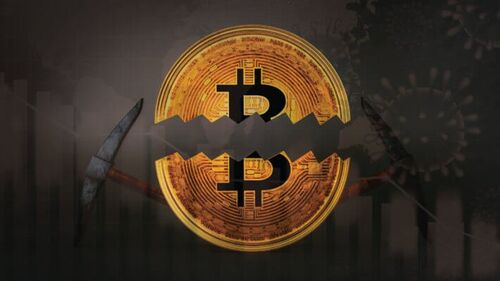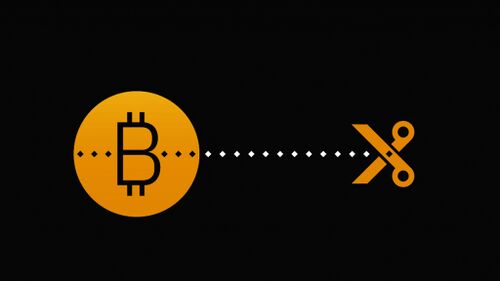Halving: Difference between revisions
| [checked revision] | [checked revision] |
No edit summary |
CryptoUser (talk | contribs) m (CryptoUser moved page Commoninfo:halving to Halving) |
||
| (2 intermediate revisions by 2 users not shown) | |||
| Line 1: | Line 1: | ||
{{#seo: | {{#seo: | ||
|title= | |title= Halving - Decimal Wiki | ||
|titlemode= append | |titlemode= append | ||
|keywords= | |keywords= Halving | ||
|description= | |description= Halving | ||
}} | }} | ||
[[File:Commoninfo-halving-710x399.jpg|500px|thumb|right]] | |||
'''Halving''' is a process when the [[reward]] of [[bitcoin]] [[miner]]s for [[mining]] [[block]]s is '''''halved'''''. Halving occurs approximately every four years. This process is necessary to control the inflation of the [[cryptocurrency]], the number of which is limited to 21 million [[token]]s. | |||
== History == | |||
Halving was developed by [[wikipedia:Satoshi Nakamoto|Satoshi Nakamoto]]. Many believe that this event had a significant impact on the price of bitcoin because the reduction in production halves the supply of new bitcoins by half. | |||
During the first halving, in 2012, bitcoin cost only '''$ 12''', during the second halving, in 2016, the price of the first cryptocurrency increased to '''$ 650'''. The third halving occurred on May 11, 2020, during which the amount of remuneration to miners decreased from 12.5 [[BTC]] to 6.25 [[BTC]]. | |||
At the time of writing this article, the cost of one bitcoin is about '''$ 57,079'''. | |||
== Why halving is needed == | |||
[[File:Commoninfo-halving-1024x576.jpg|500px|thumb|right]] | |||
''The answer to this question lies in the law of supply and demand.'' | |||
If [[coin]]s are created too quickly or the number of bitcoins is not limited, then eventually there will be so many bitcoin coins in circulation that they will have only a small value and be of little interest. One of the main disadvantages of conventional paper currencies controlled by central banks is that banks can print as much currency as they want, and if they print too much, the laws of supply and demand ensure that the value of the currency begins to fall rapidly. | |||
Bitcoin, on the other hand, is designed to mimic an asset such as gold, for example. There is only a limited amount of gold in the world, and with each gram remaining, it becomes harder and harder to mine, like bitcoin and other limited cryptocurrencies. | |||
== Next halving == | |||
Since, on average, six blocks are mined within an hour, and halving occurs ''every 210,000 [[block]]s'', every four years (adjusted in one direction or another) there will be a decrease in the reward. This means that the mining [[reward]] will be reduced by 50% compared to what it was before. | |||
For example, if today every miner receives 6,25 bitcoins for solving a block, then after the next halving, which will be approximately in 2024, he will receive only 3,125 bitcoins and so on. | |||
== Conclusion == | |||
It is safe to say that halving is one of the key and innovative ideas that allowed bitcoin to reach its current level of development. It clearly demonstrated the absence of the need for a centralized authority to control the issue and distribution of money. | |||
''In any cryptocurrency being created (where the currency of the network is an economic motivation for independent users to support the blockchain, raising their nodes and incurring costs) an economic model should be thought out, which, on the one hand, will be of interest to users in the form of earning opportunities, but at the same time provide demand for coin and protect it from inflation.'' | |||
[[Category:Commoninfo]] | |||
[[Category:Tokenomics]] | |||
[[ | |||
Latest revision as of 10:10, 15 February 2024

Halving is a process when the reward of bitcoin miners for mining blocks is halved. Halving occurs approximately every four years. This process is necessary to control the inflation of the cryptocurrency, the number of which is limited to 21 million tokens.
History
Halving was developed by Satoshi Nakamoto. Many believe that this event had a significant impact on the price of bitcoin because the reduction in production halves the supply of new bitcoins by half.
During the first halving, in 2012, bitcoin cost only $ 12, during the second halving, in 2016, the price of the first cryptocurrency increased to $ 650. The third halving occurred on May 11, 2020, during which the amount of remuneration to miners decreased from 12.5 BTC to 6.25 BTC.
At the time of writing this article, the cost of one bitcoin is about $ 57,079.
Why halving is needed

The answer to this question lies in the law of supply and demand.
If coins are created too quickly or the number of bitcoins is not limited, then eventually there will be so many bitcoin coins in circulation that they will have only a small value and be of little interest. One of the main disadvantages of conventional paper currencies controlled by central banks is that banks can print as much currency as they want, and if they print too much, the laws of supply and demand ensure that the value of the currency begins to fall rapidly.
Bitcoin, on the other hand, is designed to mimic an asset such as gold, for example. There is only a limited amount of gold in the world, and with each gram remaining, it becomes harder and harder to mine, like bitcoin and other limited cryptocurrencies.
Next halving
Since, on average, six blocks are mined within an hour, and halving occurs every 210,000 blocks, every four years (adjusted in one direction or another) there will be a decrease in the reward. This means that the mining reward will be reduced by 50% compared to what it was before.
For example, if today every miner receives 6,25 bitcoins for solving a block, then after the next halving, which will be approximately in 2024, he will receive only 3,125 bitcoins and so on.
Conclusion
It is safe to say that halving is one of the key and innovative ideas that allowed bitcoin to reach its current level of development. It clearly demonstrated the absence of the need for a centralized authority to control the issue and distribution of money.
In any cryptocurrency being created (where the currency of the network is an economic motivation for independent users to support the blockchain, raising their nodes and incurring costs) an economic model should be thought out, which, on the one hand, will be of interest to users in the form of earning opportunities, but at the same time provide demand for coin and protect it from inflation.